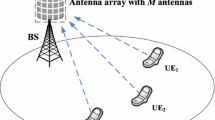Abstract
It is well known that adding more antennas at the transmitter or at the receiver offers larger channel capacity in the multiple-input multiple-output communication systems. In this letter, a simple proof is presented for the fact that the channel capacity increases with an increase in the number of receive antennas. The proof is based on the famous capacity formula of Foschini and Gans and uses matrix theory.
Similar content being viewed by others
References
Foschini G.J., Gans M.J. (1998) On limits of wireless communications in a fading environment when using multiple antennas. Wireless Personal Communications 6(3): 311–335
Telatar I.E. (1999) Capacity of multi-antenna Gaussian channels. European Transactions Telecommunications Related Technology 10: 585–595
Smith, P. J., & Shafi, M. (2002). On a Gaussian approximation to the capacity of wireless MIMO systems. In Proceedings 2002 IEEE International Conference On Communications (pp. 406–410). New York, Apr.28–May 2.
Chiani, M. (2002). Evaluating the capacity distribution of MIMO Rayleigh fading channels. In Proceedings 2002 IEEE International Symposium on Advances in Wireless Communications, Vancouver, BC, Canada, Sept. 23–24.
Chiani M., Win M.Z., Zanella A. (2003) On the capacity of spatially correlated MIMO Rayleigh-fading channels. IEEE Transactions on Information Theory 49(10): 2363–2371
Ivrlac M.T., Utschick W., Nossek J.A. (2003) Fading correlations in wireless MIMO communication systems. IEEE Journal of Selected Areas Communications 21: 819–828
Shiu D.-S., Foschini G.J., Gans M.J., Kahn J.M. (2002) Fading correlation and its effect on the capacity of multielement antenna systems. IEEE Transactions Communications 48: 502–513
Yu, K., Bengtsson, M., Ottersten, B., McNamara, D., Karlsson, P., & Beach, M. (2001). Second order statistics of LNOL indoor MIMO channels based on 5.2 GHz measurements. In Proceedings 2001 IEEE Global Telecommunications Conference(pp. 156–160). San Antonio, TX, Nov. 25–29.
Franz E.H. (1970) Elementary matrix algebra, second edition. The Macmillan Company, Collier-Macmillan Limited, London
Author information
Authors and Affiliations
Corresponding author
Rights and permissions
About this article
Cite this article
Gong, J., Soleymani, M.R. & Hayes, J.F. A Rigorous Proof of MIMO Channel Capacity’s Increase with Antenna Number. Wireless Pers Commun 49, 81–86 (2009). https://doi.org/10.1007/s11277-008-9558-2
Received:
Accepted:
Published:
Issue Date:
DOI: https://doi.org/10.1007/s11277-008-9558-2




